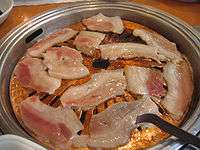Samgyeopsal
| Samgyeopsal | |
 Samgyeopsal being grilled with sliced onions and garlic on a hot plate. | |
| Korean name | |
|---|---|
| Hangul | 삼겹살 |
| Hanja | 三겹살 |
| Revised Romanization | Samgyeopsal |
| McCune–Reischauer | Samgyŏpsal |
Samgyeopsal (삼겹살; Korean pronunciation: [sʰamɡjʌps͈al]) is a popular Korean dish that is commonly served as an evening meal. It consists of thick, fatty slices of pork belly meat. The meat, usually neither marinated nor seasoned, is cooked on a grill at the diners’ table. Usually diners grill the meat themselves and eat directly from a grill. It is typically served with ssamjang (Korean: 쌈장), vegetables, and lettuce leaves to wrap it in.[1][2]
Name
The literal meaning of the word is “three (sam; Korean: 삼(三)) layered (gyeop; Korean: 겹) flesh (sal;Korean: 살)”, referring to what appears to be three layers that are visible in the meat. One can also find ogyeopsal (Korean: 오겹살), with o meaning “five”.
Popularity in Korea

According to a 2006 survey by Agricultural Cooperatives in Korea (Korean: 농업협동조합), 85% of South Korean adults surveyed stated their favorite pork is samgyeopsal.[3] The survey also showed 70% of recipients eat the meat at least once a week. The high popularity of samgyeopsal makes it one of the most expensive parts of pork. South Korea imports wholesale samgyeopsal from Belgium, the Netherlands, and other countries for the purpose of price stabilization as imported pork is much cheaper than domestic.
The South Korean government planned to import 70,000 t of samgyeopsal with no tariff in the second half year of 2011. Thus, importation of samgyeopsal was expected to expand.
Samgyeopsal is popularly consumed both at restaurants and at home, and also used as an ingredient for other Korean dishes, such as kimchi jjigae.
Accompaniments
The most common accompaniments for samgyeopsal are lettuce (sangchu; Korean: 상추) and sliced raw garlic, but very often the meat is served with other accompaniments, such as perilla leaves (kkaennip; Korean: 깻잎), sliced green chili peppers, shredded green onions, sliced raw onions, and aged kimchi (mugeunji; Korean: 묵은지). Garlic, onions, and kimchi can be either grilled with the meat or consumed raw with the cooked meat. Mushrooms, such as button mushrooms or oyster mushrooms, are also grilled with the meat.
Dipping sauce
Samgyeopsal is almost always served with at least two kinds of dipping sauces. One is ssamjang (Korean: 쌈장), a paste consisting of chili paste (gochujang; Korean: 고추장), soybean paste (doenjang; Korean: 된장), sesame oil (Korean: 참기름), and other ingredients; the other is gireumjang (Korean: 기름장), made with salt and sesame oil, sometimes also with a small amount of black pepper. Usually ssamjang is used when a diner eats samgyeopsal with vegetable accompaniments, and gireumjang when a diner wants to taste the cooked meat itself.
Consumption
Prior to consumption, the large slice of the pork belly is cut into smaller pieces with scissors. A common way to consume samgyeopsal is to place a slice of the cooked meat on a leaf of lettuce or a perilla leaf or both, with some cooked rice and ssamjang, and to roll it up in the leaf and eat it. It is usually called sangchu-ssam (Korean: 상추쌈). Cooked rice and other foods wrapped in Korean lettuce can also be called sangchu-ssam. Any combination of the vegetable accompaniments mentioned above can be added to the roll according to preference, the most popular is sliced garlic. Many people also add in kimchi, mushrooms, bean sprouts, and grilled onions. Usually, different types of banchan are added. Part of the reason so many people enjoy this food is they can customize it to their liking.
A recent trend in Korean is to serve palsaik or pal saek samgyupsal[4] literally meaning "eight colour pork belly", also known as "rainbow pork", where belly pork is marinated in eight different flavors. Common marianades include ginseng, wine, pine needles, garlic, herb, curry, soy bean paste and hot pepper sauce. Diners are invited to start with lighter flavors and progress to the strongest tasting.
See also
- Pork
- Pork belly
- Bacon
- Korean barbecue
- Korean cuisine
- List of Korea-related topics
- List of pork dishes
References
- ↑ "Hansik, Must-Eat Foods" Visit Seoul
- ↑ "40 Korean foods we can't live without" CNN Travel
- ↑ 2006 ACK Survey
- ↑ "The new colour thing: Korean rainbow pork" The Star Newspaper, Malaysia
Steele.J (2014, February 28)The Korean Blog:Blogging Korea,Sharing Experience. ZenKimchi. (2006, June 28) The Korean Food Journal. Sue. (2007, January 24) My Korean Kitchen. Oh. (2012, January) Asian- Australasian Journal of Animal Science.
External links
| Wikimedia Commons has media related to Samgyeopsal. |
